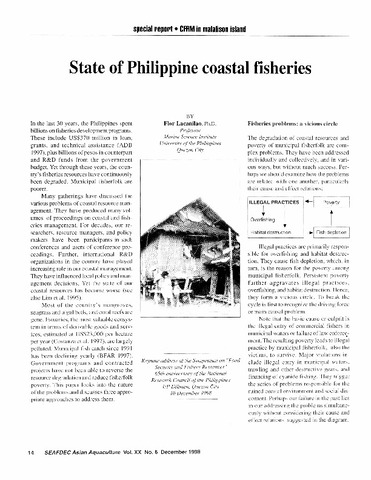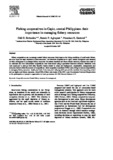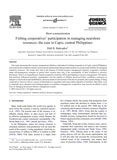Perlihatkan publikasi sederhana
Integrated water resources management: the experience of Laguna Lake Development Authority (LLDA), Philippines
| dc.contributor.author | Carino III, Jose K. | |
| dc.contributor.editor | Cuvin-Aralar, Maria Lourdes | |
| dc.contributor.editor | Punongbayan, Raymundo S. | |
| dc.contributor.editor | Santos-Borja, Adelina | |
| dc.contributor.editor | Castillo, Lourdes V. | |
| dc.contributor.editor | Manalili, Eduardo V. | |
| dc.contributor.editor | Mendoza, Marlynn M. | |
| dc.date.accessioned | 2021-07-28T00:37:48Z | |
| dc.date.available | 2021-07-28T00:37:48Z | |
| dc.date.issued | 2005 | |
| dc.identifier.citation | Carino III, J. K. (2005). Integrated water resources management: The experience of Laguna Lake Development Authority (LLDA), Philippines. In M. L. Cuvin-Aralar, R. S. Punongbayan, A. Santos-Borja, L. V. Castillo, E. V. Manalili, & M. M. Mendoza (Eds.), Proceedings of the First National Congress on Philippine Lakes (pp. 265-276). Southeast Asian Regional Center for Graduate Study and Research in Agriculture (SEARCA). | en |
| dc.identifier.issn | 1656-8099 | |
| dc.identifier.uri | http://hdl.handle.net/10862/6149 | |
| dc.description.abstract | Laguna de Bay is the largest inland body of water in the Philippines and one of the largest lakes in Southeast Asia. The lake and its watershed, technically referred to as the Laguna de Bay Region or Basin, encompasses the provinces of Rizal and Laguna, portions of Cavite, Batangas and Quezon and a large portion of Metro Manila. It is a host to a total of 66 local government units (LGUs) (49 municipalities, 12 cities and five provinces) and is home to over 10 million people. Over recent decades, uncontrolled population growth, indiscriminate deforestation and land conversion, intense fisheries, widespread industrialization, and urban sprawl have produced massive changes in the Laguna de Bay and its watershed. The resulting problems relate to solid waste management, sanitation and public health, congestion, sedimentation, unmitigated input of domestic, agricultural and industrial wastes, deteriorating water quality, flooding problems, and loss of biodiversity. The task of turning the tide of environmental degradation and of protecting and conserving the lake and its watershed for posterity calls immediate and decisive action. Using the so-called Integrated or Basin Approach to water resources management, the Laguna Lake Development Authority (LLDA) has initiated a number of innovative actions that could spell the difference in the effort to save Laguna de Bay. These include: a) the Environmental User Fee System (EUF), a market-based instrument designed to motivate polluters to comply with effluent standards; b) Zoning and Management Plan (ZOMAP) for fish pens and fish cages; c) Shore Land Development and Management Plan (SMDP); and d) the River Rehabilitation Program. The module for River Rehabilitation developed over seven years has produced a model for multistakeholder and community participation and involvement in the task of resource conservation and management which is gaining recognition internationally. | en |
| dc.language.iso | en | en |
| dc.publisher | Southeast Asian Regional Center for Graduate Study and Research in Agriculture (SEARCA) | en |
| dc.subject | Laguna de Bay | en |
| dc.subject | River Rehabilitation Program | en |
| dc.subject | Integrated basin approach | en |
| dc.subject | Environmental user fee | en |
| dc.subject | Zoning and management plan | en |
| dc.subject | Philippines | en |
| dc.subject | zoning | en |
| dc.title | Integrated water resources management: the experience of Laguna Lake Development Authority (LLDA), Philippines | en |
| dc.type | Conference paper | en |
| dc.citation.spage | 265 | en |
| dc.citation.epage | 276 | en |
| dc.citation.conferenceTitle | Proceedings of the First National Congress on Philippine Lakes | en |
| dc.subject.asfa | water resources | en |
| dc.subject.asfa | resource management | en |
| dc.subject.asfa | lakes | en |
| dc.subject.asfa | water pollution | en |
| dc.subject.asfa | management | en |
| dc.subject.asfa | river restoration | en |
| dc.subject.asfa | watersheds | en |
Files in this item
| Files | Size | Format | View |
|---|---|---|---|
|
There are no files associated with this item. |
|||
Publikasi ini ada di koleksi berikut
-
LakeCon2003 [49]
Proceedings of the First National Congress on Philippine Lakes



